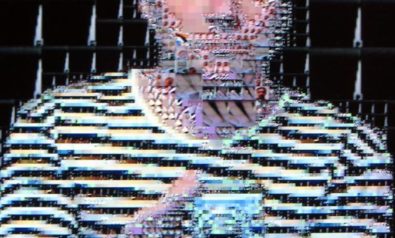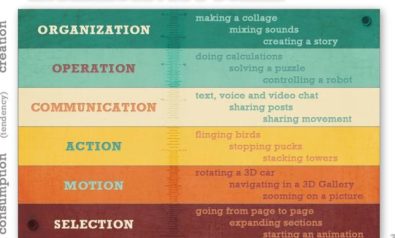On the role of social change and technology as stepping-stones to interaction in the arts.
The concept of interactivity in the arts predates the 1968 Social Revolution which defined freedom as the possibility to participate. However, as some early examples show, the concept was not new. In literature, Hermann Hesse’s renowned novel of 1927, “Steppenwolf”, evokes the idea of a magic theatre, where the performance would be guided by the thoughts of the spectators. And in 1961, French writer Robert Queneau applied the idea of interactivity to literature with his “cent mille milliards de poemes”, a veritable ‘poem-kit’, with which the reader was offered the opportunity to create ever-new poems with predefined pieces. And in 1954 the first tangible structure considered as truly interactive was erected near Paris; the sound producing spatiodynamic cybernetic tower by Nicolas Schöffer. Using mirrors and lights, it was highly technical, and in the nature of interactive art, it was able to interact in real time with numerous ecological and environmental factors.
Post-1968, the idea of interactivity seemed to explode. Peter Vogel built the first cybernetic objects in ’69 and ten years later generated a series of musical installations: “Die Klangwand”, which would react to the shadows that dancers and the public cast on it, with light and sound. Another eminent figure in the domain of interactive sound experience is Iannis Xenakis with his UPIC – again a highly technical device, which transforms graphics into sound.
Owing to their technical potential, the new media arts, including video games, now form the majority of contemporary interactive art forms. Active since the 1960s, Jeffrey Shaw is a leading figure in the domain, pioneering the creative use of digital media in interactive narrative and virtual reality. One of his most famous works is the 1994 interactive installation of the “Golden Calf”, where the spectator moves around an empty pedestal, equipped with a viewing device that offers the realistic visualisation of the “Golden Calf” from every angle. A few years earlier, in “Legible City”, Shaw already made the pedalling spectator “move” through a virtual city on an actual, although static, bike.
After a period of experimentation with the technological possibilities offered to art, interactive art today is used as a tool to also transport political themes.For example, a Swiss installation, called “the oracle of the butterfly”, an allegory to the famous question raised in 1972 by climatologist Edward Lorenz: “Can the flapping of a butterfly’s wings in Brazil generate a Tornado in Texas?” offers the public an environmental experience in a poetic atmosphere. By individually taking an “environmental action”, the public can light up butterflies on the walls. Once all lit, beautiful music emerges and a menacing tornado is reduced to nothingness. Another project, “Cosmopolis – overwriting the city” conducted in China by Maurice Benayoun, is an artistic and scientific interpretation of urbanisation. The spectator views fragments of Eastern and Occidental Cities, where the environment is cut out, to concentrate on different selected aspects. Only later does one realise, that by viewing the pictures they build up an imaginary Cosmopolis of their own, which seems strangely familiar and bizarre at the same time. Other projects offer the possibility to re-explore one’s everyday environment. The “Space Invaders” mosaics by an incognito French street artist, who defines his project as a reality game, are found in several big European cities. Fans and followers will wander between them, walking through areas they probably wouldn’t have ventured to if it weren’t for the Invaders. To engage in the artistic process, some fans recreate Invaders in their home-cities in homage to the creator.
New dimensions of interactivity also emerge with the internet: Google+ makes it possible to organize hangouts, and the 2009 Youtube symphony orchestra brought together musicians from all around the world to perform at once, and in doing so defied the rules of space and time. One may also argue whether integrating the public through internet crowd-sourcing in cinematographic art, as it happened for futuristic “Iron Sky”, presented at the 2012 Berlinale, may also be considered as interactive. Finally, the ICINEMA Research Center in New South Wales now experiments with avatars in the movies in its Scenario Project. As neurobiologist Horst Müller predicts, it seems even books are bound to become interactive and will directly communicate with the reader, as artificial intelligence technologies evolve. This last not yet fully explored technology will certainly add another interesting aspect to art – just as will others yet to be invented.
Support Fair Observer
We rely on your support for our independence, diversity and quality.
For more than 10 years, Fair Observer has been free, fair and independent. No billionaire owns us, no advertisers control us. We are a reader-supported nonprofit. Unlike many other publications, we keep our content free for readers regardless of where they live or whether they can afford to pay. We have no paywalls and no ads.
In the post-truth era of fake news, echo chambers and filter bubbles, we publish a plurality of perspectives from around the world. Anyone can publish with us, but everyone goes through a rigorous editorial process. So, you get fact-checked, well-reasoned content instead of noise.
We publish 2,500+ voices from 90+ countries. We also conduct education and training programs
on subjects ranging from digital media and journalism to writing and critical thinking. This
doesn’t come cheap. Servers, editors, trainers and web developers cost
money.
Please consider supporting us on a regular basis as a recurring donor or a
sustaining member.
Will you support FO’s journalism?
We rely on your support for our independence, diversity and quality.








Comment